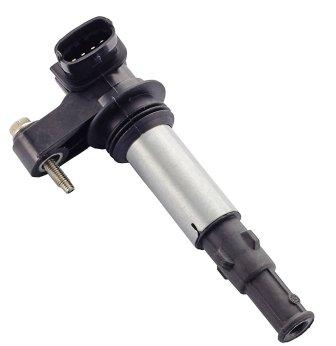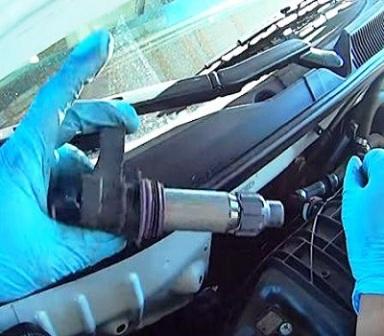GM V6 Ignition Coil Problem
Before we get into this GM V6 ignition coil problem I wanted to make it clear that I'm not bashing the reliability of the General Motors 3.6 L V-6 engine.
In fact, the automobiles I've seen with ignition coil failure had more than 150,000 miles on them. With that said, it would be nice if the original coil lasted as long as the engine.
In addition, some of these V-6 engines received poor quality timing chains from the factory. However, we'll save that story for another day.
For those that don't like to read a long-winded page about how coils work, common symptoms and affected vehicles let me share my solution to the problem with you first.
New Parts : Pack of 6 Ignition Coils for Cadillac, Chevy And GMC. Fits Camaro, CTS, SRX, Equinox and Impala V6 3.0L 3.2L 3.6L.
Unlike the Chevrolet Cruze ignition coil rail you can purchase these components individually. Therefore, when I first ran into the problem I would find and replace the individual failed coil.
However, using this method the vehicle owner wound up coming back in a couple of months with a different coil malfunctioning.
Replacing one coil at a time began to chip away at my reputation of fixing it right the first time. It's not good for business to have a comeback.
Mechanics call a comeback a situation when the car owner finds it necessary to return for the same repair.
 GM V6 Ignition Coil Problem
GM V6 Ignition Coil ProblemEven though we had a different failed component the customer felt that maybe I should have addressed this in the first place.
Although I'm not a fan of replacing parts that aren't bad it would seem that these coils are destined to fail when they reach the 10 year or 150,000 mile mark.
This is why I threw my usual course of action in the trashcan. In the old days I would replace the individual coils with factory original parts.
However, a complete set of aftermarket coils comes in at a cheaper price point than one individual AC Delco coil purchased from a dealership parts department.
So this is my cost-effective solution that reduces repeat failures. I replace all the coils when one fails. I also go aftermarket and get a whole set instead of replacing individual components.
Now that you know my secret I'm hoping that you will continue to read this page as I have other details to supply. Including a few other tune-up and maintenance items you should also perform when tackling this GM V6 ignition coil problem.
Cars with the GM V6 Ignition Coil Problem
As promised, I wanted to supply a sampling of vehicles known to suffer from this ignition coil problem.
As many of you know, General Motors installed the 3.6 L and 2.8 L engine in a lot of vehicles. However, the most common years to suffer from this condition include those from 2004 through 2009.
With that said, the list that follows remains just a sampling of automobiles that use this type of GM V6 ignition coil.
Cadillac 3.6 L CTS 2004-2009, Cadillac CTS 2005-2007 2.8 L, Cadillac SRX 3.6 L 2004-2006, Cadillac STS 2005-2009 3.6 L, Buick Allure 2005-2008 3.6 L, Buick Enclave 3.6 L 2009, Buick LaCrosse 2005-2008 3.6 L,
Buick Rendezvous 3.6 L 2004-2006, Chevrolet Traverse 2009 and the GMC Acadia powered by the 3.6 L V-6 engine. The Saturn and Pontiac lines also carry this engine and therefore can experience this GM V6 ignition coil problem.
Symptoms of a Bad Ignition Coil
 GM V6 Ignition Coil
GM V6 Ignition CoilFrom the driver's point of view the symptoms become severe when an ignition coil starts to fail. They can get a bucking, sputtering and a lack of power. Drivers often complain about the check engine light coming on.
This means the automobile's main computer stored a diagnostic trouble code. If the check engine light starts flashing that means it's time to stop driving the car. We'll get into why at the end of this section.
The check engine light becomes important information for finding out what cylinder has the ignition coil problem.
Especially if you only want to replace the one bad coil. Vehicles often set random misfire codes or a diagnostic trouble code for a particular cylinder.
These codes all fall within the P0300 range. In addition to the check engine light and the drivability symptoms, car owners might also complain about exhaust odors.
Here's why people need to take this ignition coil failure issue seriously. When the cylinder doesn't fire, raw fuel finds its way into the exhaust system. This fuel can pool up in the catalytic converter.
This can destroy a perfectly good catalytic converter and these parts are not cheap to replace. This is why you see people complaining about thousand dollar tune ups on these 3.6 L V-6 engines.
Replacing the coils, spark plugs and the catalytic converters pushes these repairs into the thousand dollar range.
Replace the Coils and the Spark Plugs
Often when I remove the ignition coil I find the original equipment spark plugs still in the engine.
General Motors puts a small dot of paint on the top of each plug they install on the assembly line. Usually you find a spot of green or purple paint.
They designed these iridium or platinum spark plugs to go 100,000 miles or 10 years. When something lasts that long it's easy to forget about it all together.
This is another reason that replacing these coils turns into something bigger and more expensive. The platinum spark plugs aren’t cheap and you can multiply the expense times six.
But you might as well do it while you're there. In the next section we'll talk a little bit about the service procedure.
With that said, before you start removing the ignition coils or the spark plugs you need to blow the sand dirt and debris away from the spark plug tunnels.
You can use those computer keyboard air dusters if you don't have access to compressed air. I recommend using a specially designed spark plug socket. This has a rubber boot inside that extracts the plug from the tunnel.
Finally, don't over tighten the spark plugs when you install them. The 3.6 L aluminum cylinder heads have delicate spark plug threads. Snug the spark plugs down, but don't crush them.
The Ignition Coil Service Procedure
Unfortunately when you run into this GM V6 ignition coil problem, solving the issue is often model and year specific.
One of the big things to consider is you might have to pull off the Plenum. More specifically separate the plenum from the lower intake manifold.
With that said, there are models that you can get away without removing the plenum.
The 3.6 L V-6 engine found in the Chevrolet products you can often find a way to remove the coil by rotating it before trying to pull up on it.
Here’s a YouTube video demonstration of a gentleman replacing Chevrolet ignition coils without removing the intake plenum.
On other models this trick doesn't work. Nevertheless, removing the plenum is not a big deal on models like the GMC Acadia and the Chevrolet Traverse.
You can go to your favorite video service and search down the service procedure for your specific year, make and model.
Author bio : Mark is a retired ASE certified master technician, Chevrolet Professional Service Council member and the founder of FixMyOldRide.com. Watch the video on the about Mark the mechanic page to see his credentials. Mark hand writes all of the articles on FixMyOldRide.com unless indicated otherwise.